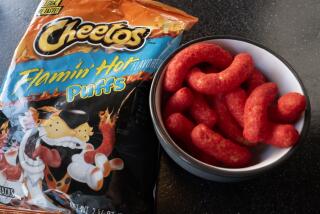Attack of the Tasteless Tomatoes
- Share via
DAVIS — All across the land, tomato time is coming. Each morning now I peek into my back yard to check the pulse of the tomato families growing there. Just making sure. I figure there must be a million like me in Fresno and Berkeley, all of us waiting for our Better Boys and Celebrities to go ballistic, waiting for the hard, green golf balls nestled in the leaves to turn fat and red. Then it will be summer, and tomato time.
Except at this place. At some point, I am convinced, history will identify the University of California, Davis, as the spot where the tomato had its soul stolen. Oh, Davis may first seem innocuous. Do not be fooled. This is the province of Food Science, and its practitioners created here the Treblinka of the tomato. They are the reason why we are forced to grow our own.
That the tomato was martyred here--and not in Iowa or Florida--left California marked in a curious way. Like the brilliant flowers that have no fragrance, the non-tomato has come to be a cultural artifact of our state, an item of sly disgrace. Some professors at Davis won’t talk about it even today. Tomato paranoia. Perhaps that’s because the flowers were put there by God. This thing they invented.
America, as far as anyone knows, produced wonderful commercial tomatoes until the early 1960s. That’s when the California growers and the Food Scientists discovered they could perpetrate the tomato fraud. They produced, via the evil of plant breeding, a tomato that looked good, felt good, and tasted like wet newspaper.
This tomato was a death zone of taste, but underneath its skin the Food Scientists had engineered a superstructure that would withstand the insults of machine processing. This proto-tomato arrived at the supermarket looking for all the world like a real tomato, rosy and firm to the touch. In fact, it was a poseur, a pneumatic marvel so hard it would bounce off the kitchen floor like Silly Putty. We’ve been stuck with it ever since.
Well, guess what. Davis is trying to redeem itself. The boys over at Food Science have been working on the problem and a new tomato may be on the horizon. No promises, but maybe they will fix things so we can buy a real tomato at Ralphs and not have to grow our own anymore.
It was the philosopher Nietzsche, I believe, who said the way out of sin is not back to the child but ever deeper into evil itself. And so with Food Science. This new tomato will be the product of the latest in biotech, its tastes and textures manipulated in ways the old plant breeders could only dream about.
Just last January a Davis company known as Calgene was awarded U.S. patent No. 4,801,540 for a process that would alter the DNA of tomatoes and keep them firm over much longer periods. Of course, firmness is no problem for your standard baseball tomato being offered today. But what if you took this gene, asks Food Scientist William Hiatt, and put it in a real tomato?
“The basic problem of the tasty tomato is that it’s perishable,” says Hiatt. “By the time you get it to the supermarket, it’s mushy. In fact, the mushiness accelerates when it hits vine ripe.”
With the new gene, Hiatt says, a tomato would soften normally up to the vine ripe stage and then maintain. Mushiness would be inhibited, the growers would get the product to the shelf with all its cosmetic splendor intact, and we would get our taste back. Hiatt, an enthusiastic man, drew some graphics on a blackboard showing descending rates of mushiness.
Do you believe this is actually going to put good tomatoes on the shelves at Ralphs? Nah, and I don’t either. Something will go wrong. Even Calgene says it is not sure the gene will do what it hopes. They are testing now, trying to find out if their transgenic creations will taste like tomatoes or cucumbers.
There may be other ways to go about this. One Food Scientist at UC Davis told me his people are attacking the taste problem directly, isolating the trace substances that contribute to essential tomato-ness. So far they have found some 400 of these elements, among them ethers, ketones, phenols, alcohols, hydrocarbons and aldehydes. It may be a while, they say, before they get a handle on this. They will let us know.
And maybe they won’t. Perhaps the business of fixing the tomato is too tough for Food Science. When I was leaving Calgene I noticed there was a lot across the street that has been converted to a neighborhood garden. There’s squash there and lettuce and probably a hundred tomato plants. All kinds of tomatoes, from little Romas to huge Beefsteaks. It occurred to me that Davis might have done us a favor after all. It forced us into our back yards again, where each summer our green plants do what the Food Scientists, with their computers and gene splicers, can no longer manage.
More to Read
Eat your way across L.A.
Get our weekly Tasting Notes newsletter for reviews, news and more.
You may occasionally receive promotional content from the Los Angeles Times.








